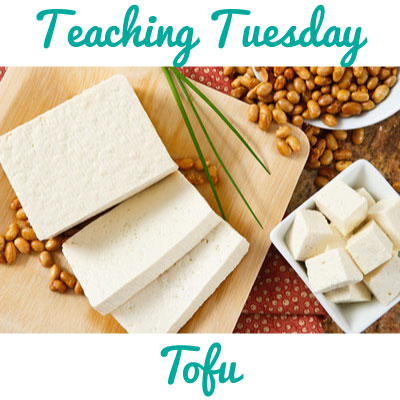It's the Teaching Tuesday you've been waiting for: tofu! (Try saying "Teaching Tuesday Tofu" three times fast!)
I think tofu is pretty hit or miss. Some people LOVE it, while others can't get past the texture.
Whatever side you may be on, the good news is tofu's a blank canvas (or in this case, a block canvas), which means it's quite versatile and can easily be transformed!

What is it?
Tofu is bean curds made from coagulating soy milk into curds. These curds are then put into forms and pressed to create a large block of tofu. The large block is then cut into smaller blocks and packaged in filtered water.
Tofu, in general, is very high in protein and low in calories. It's also pretty tasteless, so it lends well to many flavors.
Types
Silken: Silken tofu is just how it sounds, silky. It is great for making sauces and creams because of it's smooth and pudding-like texture. You can find silken tofu in the refrigerated section of the store or in a Tetra Pack on shelf in an aisle (Mori-Nu is the most common shelf-stable brand).
Firm/Extra Firm: Extra-firm is much firmer than Firm. Firm and Extra-Firm tofu work best for when the tofu needs to hold together such as in stir-fries, or when you're making Baked Tofu (HHC, pg. 138), or crumbled as in HH's Tofu Scramble. Note that if the recipe calls for cubing the tofu into small pieces, the firmer the better.
I once used firm tofu once in place of silken tofu when making HH's Sour Cream (EHH, p. 274). I ran the firm tofu through the blender a few times by itself with a little nondairy milk before making the recipe so it was somewhat silken in texture. It wasn't quite as creamy as usual, but it still worked in a pinch.
On the flip side, you generally can't substitute the silken for firm or extra-firm.
Sprouted: Sprouted tofu is the same as regular tofu, except it is made from sprouted soy beans. While there is no difference in how you would cook with sprouted tofu (it is still labelled as firm, extra-firm, etc) there is a difference nutritionally. Sprouted tofu generally has more calories and fat than regular tofu, but also more protein.
How to press tofu
Occasionally a recipe may call for "pressed tofu". You're probably wondering "what's the point of pressed tofu"? When you press tofu, you're pressing out excess water, which allows more flavor to be absorbed while cooking.
I once had a fancy tofu press, but since I never used it, I gave it away. Now whenever I need to press tofu, I use regular objects anyone can find around the house. Here's how to press in 5 easy steps:
- Remove tofu from package, drain away excess water
- Wrap tofu in a clean dish towel.
- Place wrapped tofu on a cutting board or plate.
- Place another cutting board or baking sheet on top of tofu and add heavy objects (i.e. books, cans of beans) to press out water.
- Leave heavy objects on tofu for about 30 minutes, but stay close in case your objects shift.
Freezing tofu
Many people don't like the texture of tofu. If that's the case, try freezing it! It's a great way to change the texture (it makes it a little more chewier) without much effort. The color also changes when frozen, but will go back to it's off-white shade once thawed. See this post for details: How to Freeze Tofu
Allergic to soy, or maybe tofu isn't your cup of tea?
No problem! See my post on How to Replace Tofu. I also recently shared on Facebook about a new brand of soy-free hemp tofu hitting the market. I haven't personally used it, but it's nice to see that alternatives are slowly but surely becoming available!
Do you like tofu? If so, how do you enjoy it?













